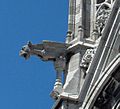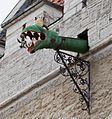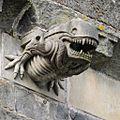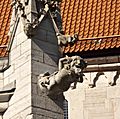Gargoyle facts for kids
A gargoyle is a special kind of statue found on old buildings. It's usually carved from stone, like granite. Its main job is to help rain water flow away from the building. Gargoyles often look like strange animals or people. The water comes out of their mouths, protecting the walls below.
Long ago, people believed gargoyles also scared away bad spirits. You can see many gargoyles on old cathedrals and churches. Today, most new buildings use rain gutters instead of gargoyles.
It's easy to mix up gargoyles with other grotesque statues. The big difference is that only gargoyles are designed to spout water.
-
Gargoyles at Notre Dame Cathedral in Paris, France
Contents
What is a Gargoyle?
A gargoyle is a carved stone figure. It is attached to the side of a building. These statues are more than just decorations. They have a very important job. They help move rainwater away from the walls. This stops the building from getting damaged over time.
How Gargoyles Work
When it rains, water collects on the roof. The gargoyle's body has a channel inside it. This channel carries the water from the roof. The water then flows out of the gargoyle's mouth. This sends the water far away from the building's foundation. It's like a fancy, ancient rain gutter.
Why They Look So Unique
Gargoyles are known for their unusual looks. Many are carved to look like scary or funny creatures. You might see them as dragons, lions, or even strange human-like figures. This unique look was not just for fun. People in the past believed these figures could protect buildings. They thought the scary faces would scare away evil spirits or bad luck.
Gargoyles vs. Grotesques
It's easy to confuse gargoyles with other stone carvings called grotesques. Both are often found on old buildings and look similar.
The Main Difference
The key difference is their purpose. A gargoyle always has a water channel. It is designed to spout water away from the building. If it doesn't move water, it's not a gargoyle. A grotesque, on the other hand, is a decorative carving. It might look like a strange creature or person, but it doesn't have a water channel. It's purely for decoration.
Where Can You Find Gargoyles?
Most gargoyles were made a very long time ago. They are often seen on Gothic cathedrals and churches in Europe. Famous examples include Notre-Dame de Paris in France.
Gargoyles Today
Today, new buildings rarely use gargoyles for drainage. Modern buildings use simple rain gutters and downspouts. These are less artistic but very effective. Because of this, gargoyles are mostly found on historic buildings. They are a reminder of old building methods and beliefs.
Images for kids
-
Gargoyles of Notre-Dame de Paris
-
Dragon-headed gargoyle of the Tallinn Town Hall, Estonia
-
A gargoyle on the Basilique du Sacré-Cœur, Paris, France, showing the water channel
-
One of four gargoyles atop the Peace Tower, Ottawa, Ontario, Canada
-
Gargoyle of Notre-Dame d'Amiens, France
-
Notre Dame Church in Dijon, France
-
Gargoyle on Zagreb Cathedral, Croatia
-
Gargoyle from Cologne Cathedral under reconstruction
-
Gargoyle showing carver Roger Morigi with carver's tools, Washington National Cathedral, Washington D.C., USA
-
Gargoyle from Rosslyn Chapel, Roslin, Scotland.
-
Gargoyle from the Château de Blain, France
-
A 1st century BC Hellenistic gargoyle representing a comical cook-slave from Ai Khanoum, Afghanistan
-
During a refurbishment of Paisley Abbey in the early 1990s, twelve gargoyles were replaced. One of them is modeled on the titular creature from the 1979 film Alien.
-
Gargoyle representing a comical demon at the base of a pinnacle with two smaller gargoyles, Visby, Sweden
See also
 In Spanish: Gárgola para niños
In Spanish: Gárgola para niños

























